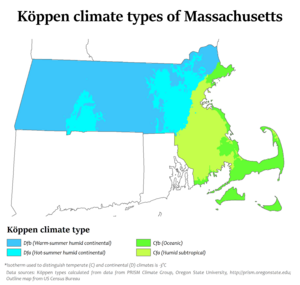Climate change in Massachusetts facts for kids
Climate change in Massachusetts means big changes for the state. It affects cities, towns, forests, and even the ocean. Things like fishing, farming, and building near the coast are all impacted. Scientists expect the Northeast United States to get warmer faster than other parts of the world. By 2035, it could be more than 3.6°F (2°C) warmer than it was a long time ago.
What Climate Change Does to Massachusetts
Rising Sea Levels and Flooding
The ocean around Massachusetts is rising. This means more flooding, especially during big storms. Cities like Boston are already planning for this. They are looking at ways to protect areas like East Boston, Charlestown, and South Boston. This might involve raising land or building temporary walls.
Experts have studied building a huge barrier to protect Boston Harbor. However, they found that many smaller projects on land would work better and cost less. In 2016, Massachusetts made a plan to deal with climate change across the whole state.
A big storm in 2018, called a noreaster, caused a lot of flooding. Places like downtown Boston, Quincy, and Scituate were hit hard. This showed how serious rising sea levels can be.
Effects on Nature and Food

Climate change also affects how we get our food. Fishing and farming in Massachusetts are changing. Marshlands along the coast are very important. They help protect the land from storm waves. But many of these natural areas have been lost due to building.
Some of Massachusetts' famous products are also being impacted. For example, warmer weather and waters are making it harder to grow cranberries. The amount of maple syrup produced has also gone down because of climate change.



